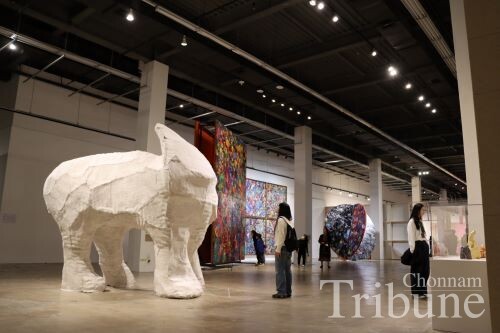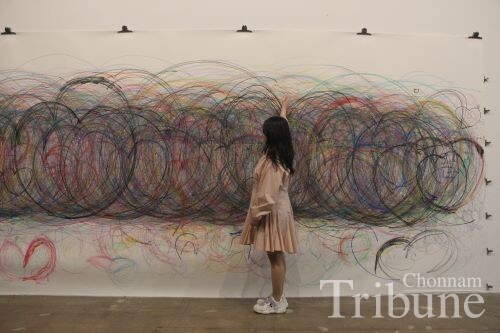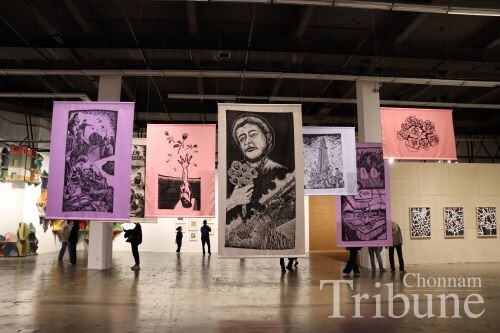
“There is nothing softer and weaker than water, and yet there is nothing better for attacking hard and strong things.” With this paradoxical statement from a line in chapter 78 of Dao De Jing, the 14th Gwangju Biennale invites visitors to consider the transformative power of water as a metaphor and a method. The theme of this year's event, "Soft and Weak like Water," celebrates the fluid and adaptable nature of water, which can erode even the strongest barriers and reshape the landscape over time. A celebration of contemporary art from around the world, the event will run until July 9 and features the works of more than 79 artists from 32 countries, showcasing a diverse range of styles, themes, and mediums. The Chonnam Tribune headed to the Gwangju Biennale Exhibition Hall to explore the four main exhibits of this year's Gwangju Biennale.
Luminous Halo
One of the standout exhibits is "Luminous Halo" that discusses the Gwangju Biennale's focus on resistance and solidarity, inspired by the May 18 Democratization Movement. The exhibit features works that examine issues of democratization, economic and social alienation and discrimination from various cultural contexts. Thasnai Sethaseree, for example, presents a combination of collage and oil pastel techniques, overlaying imageries that are suggestive of political violence and resistance. Although his artwork, "The Tower of Bubbles" refers to the political state of Thailand, it is not hard to find connections to places like Gwangju. Lee Sung-ha, a visitor from Naju, said, “It was interesting to find the subtext behind what seemed like a bunch of meaningless dots.”
Ancestral Voices
Another notable exhibit is "Ancestral Voices." It showcases artworks that look at connections between traditional healing methods, community practices, and crafts across borders. It sheds light on violent histories of colonization, explores indigenous learnings, and proposes cultural traditions as assets for non-Western communities. Here, spectators are encouraged to become the artist, contributing to the creation of art themselves. "Bodyscape," an interactive art installation by Lee Kun-yong, asks participants to draw curves on a wall using colored pencils. Tribune reporters observed as enthusiastic visitors left their own mark, the wall filling up with curves of different colors, shapes, and sizes.

Transient Sovereignty
“Transient Sovereignty” highlights discussions on colonialism and post-colonialism relating to issues such as migration and diaspora. It covers various historical examples of colonization and argues that colonialism continues to manifest in contemporary issues like multiculturalism and class struggles. The artworks in the exhibit focus on communities and individuals affected by colonialism, challenging societal norms and ultimately advocating for de-colonial thinking and practices as a means to create optimistic futures. It includes works by artists such as Naiza Khan, whose installation "Deep Conquest 2023" showcases how structures of colonial power can shape geography. According to the exhibit notes, it "presents representational and abstract modes of thinking that respond to the ways in which water features in the history of colonial empires."
Planetary Times
“Planetary Times” explores diverse artistic responses to the climate emergency, reimagining the Earth as a site of shared connections beyond national borders. It calls for a fundamental reconsideration of unequal economic infrastructures and the significance of global solidarity in facing humanity's crises, moving away from homogenous perspectives to value the lived experiences of artists and their activist possibilities. For this exhibit, Judy Watson used natural ingredients from rivers and streams in Australia to paint memories of landscapes that were restructured during colonial rule. She titles her work after the location from which the ingredients were found in a way the indigenous communities of Australia would. Gwangju citizen Kim Chae-young said, “I could almost imagine being in the locations the artwork was based on. I definitely want to check out more of her work.”

Plunge into the Depths of Contemporary Art
With visitors from all around the globe, the Gwangju Biennale is an event for all, from avid art enthusiasts to average families looking for a good time. Overall, the 14th Gwangju Biennale offers a unique opportunity to explore the cutting edge of artistic expression and engage with the issues that matter most to artists around the world. With its diverse range of exhibits and programs such as various workshops, symposiums and experience-based programs for children, the biennale is a must-visit event for anyone interested in contemporary art.
By Lee Younny, Editor

